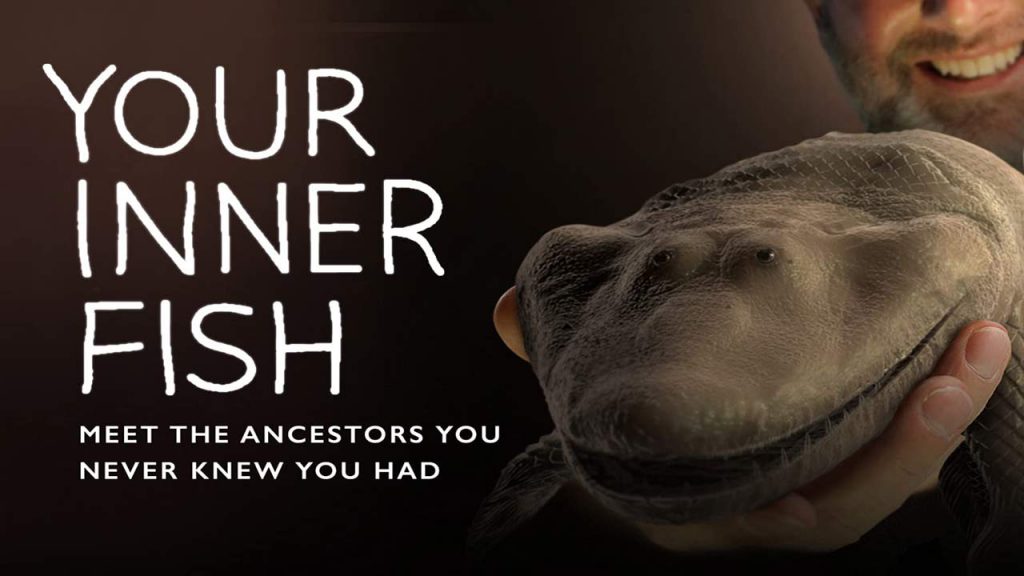Your Inner Fish: An Evolution Story episode 2 traces our hair, skin, teeth, jaws and sense of hearing back to reptilian ancestors – from ferocious beasts that ruled the Earth, to a little shrew-like animal that lived 195 million years ago.
It took more than 350 million years for the human body to take shape. Anatomist Neil Shubin reveals how our bodies are the legacy of ancient fish, reptiles and primates – the ancestors you never knew were in your family tree. Our bodies carry the anatomical legacy of animals that lived hundreds of millions of years ago.
Journeying to the Arctic, South Africa, and Ethiopia, Neil uncovers an astonishing story spanning hundreds of millions of years, a tale full of strange facts and remarkable insights. Using fossils, embryos and genes, each of the three episodes focuses on a key transitional moment in the evolution of the human body: moving from the sea to land, relocating from the shore to living in trees, and coming down from the trees to walk upright on two legs.
Your Inner Fish: An Evolution Story episode 2
The evolution of humans is a fascinating journey that spans millions of years. It all started with fish, which are considered to be the first vertebrates to emerge from the ocean and adapt to life on land. Over time, these fish evolved into amphibians, which had limbs and could breathe air. As the amphibians continued to evolve, they developed into reptiles. Reptiles were cold-blooded and had scaly skin that helped them regulate their body temperature. Some of these reptiles, such as dinosaurs, became giant creatures that dominated the earth for millions of years.
But eventually, a new type of reptile emerged that was different from all the others. This new reptile was warm-blooded, had fur, and walked on two legs. It was the first mammal and its descendants eventually gave rise to primates, including humans. The primates, in turn, evolved into hominids, which had larger brains and were able to walk upright. These hominids then gave rise to the first humans, known as homo erectus. Over time, the humans evolved into homo sapiens, which had even larger brains and were capable of language, tool use, and other advanced behaviors.
Thus, the evolution of humans can be traced back from fish to reptiles, from reptiles to mammals, from mammals to primates, from primates to hominids, and from hominids to homo sapiens. It’s a remarkable journey that has taken millions of years and shaped the human species into what we are today.
Amphibian
Amphibians are four-limbed and ectothermic vertebrates of the class Amphibia. All living amphibians belong to the group Lissamphibia. They inhabit a wide variety of habitats, with most species living within terrestrial, fossorial, arboreal or freshwater aquatic ecosystems. Thus amphibians typically start out as larvae living in water, but some species have developed behavioural adaptations to bypass this.
The young generally undergo metamorphosis from larva with gills to an adult air-breathing form with lungs. Amphibians use their skin as a secondary respiratory surface and some small terrestrial salamanders and frogs lack lungs and rely entirely on their skin. They are superficially similar to reptiles like lizards but, along with mammals and birds, reptiles are amniotes and do not require water bodies in which to breed. With their complex reproductive needs and permeable skins, amphibians are often ecological indicators; in recent decades there has been a dramatic decline in amphibian populations for many species around the globe.
The earliest amphibians evolved in the Devonian period from sarcopterygian fish with lungs and bony-limbed fins, features that were helpful in adapting to dry land. They diversified and became dominant during the Carboniferous and Permian periods, but were later displaced by reptiles and other vertebrates. The origin of modern amphibians belonging to Lissamphibia, which first appeared during the Early Triassic, around 250 million years ago, has long been contentious. However the emerging consensus is that they likely originated from temnospondyls, the most diverse group of prehistoric amphibians, during the Permian period.
Reptile
Reptiles, as most commonly defined are the animals in the class Reptilia, a paraphyletic grouping comprising all sauropsids except birds. Living reptiles comprise turtles, crocodilians, squamates (lizards and snakes) and rhynchocephalians (tuatara). As of March 2022, the Reptile Database includes about 11,700 species. In the traditional Linnaean classification system, birds are considered a separate class to reptiles. However, crocodilians are more closely related to birds than they are to other living reptiles, and so modern cladistic classification systems include birds within Reptilia, redefining the term as a clade. Other cladistic definitions abandon the term reptile altogether in favor of the clade Sauropsida, which refers to all amniotes more closely related to modern reptiles than to mammals. The study of the traditional reptile orders, historically combined with that of modern amphibians, is called herpetology.
The earliest known proto-reptiles originated around 312 million years ago during the Carboniferous period, having evolved from advanced reptiliomorph tetrapods which became increasingly adapted to life on dry land. The earliest known eureptile (“true reptile”) was Hylonomus, a small and superficially lizard-like animal. Genetic and fossil data argues that the two largest lineages of reptiles, Archosauromorpha (crocodilians, birds, and kin) and Lepidosauromorpha (lizards, and kin), diverged near the end of the Permian period. In addition to the living reptiles, there are many diverse groups that are now extinct, in some cases due to mass extinction events. In particular, the Cretaceous–Paleogene extinction event wiped out the pterosaurs, plesiosaurs, and all non-avian dinosaurs alongside many species of crocodyliforms, and squamates (e.g., mosasaurs). Modern non-bird reptiles inhabit all the continents except Antarctica.




